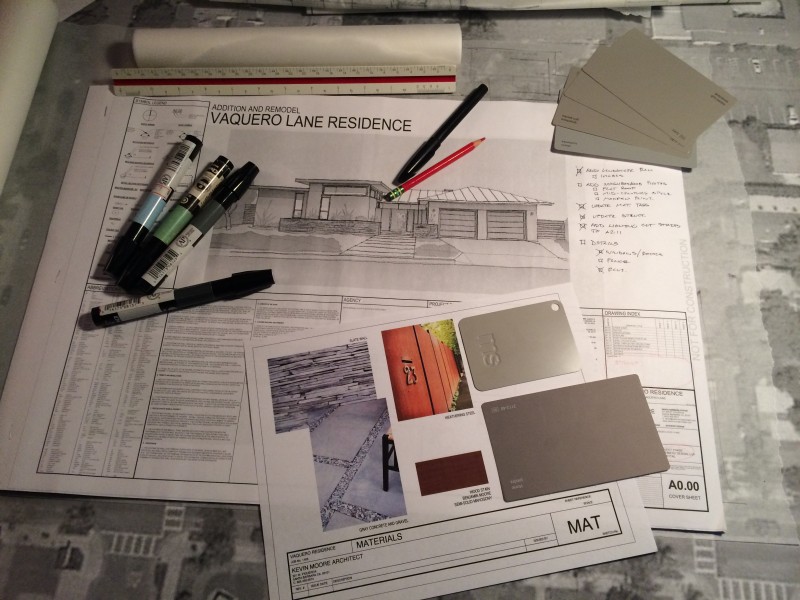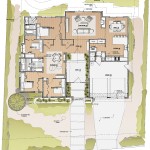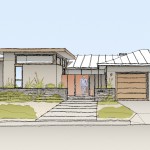We get a lot of questions from non Architects about the design process and building a house in Santa Barbara so wanted to share our experience with you. The process is normally broken down into 5 steps or phases as Architects like to call them, these phases take the project from the first meeting through the design process, permitting and construction. From the client’s point of view it may seem a bit odd, why so many steps? can’t we skip a few and get right to the permitting? We hope the following helps to shed some light on each of these phases and shows why they are each are important steps for the project and ultimately happy clients.
PRE-DESIGN
The Interview
This is usually a conversation either a phone call or a meeting where the client and Architect try and figure out if they are a good fit for each other. The client may have seen a project or been referred to the Architect by a friend but as always a good conversation will give you a better sense of each other. Information will be traded and normally the client explains what they would like to do, we like to try and get a sense of the budget, project scope and schedule at this time. Sometimes the scope is too large for the budget or the schedule is not realistic and we will warn the client immediately, thats our job, no one benefits from jumping into a project with false expectations. That being said more often than not the client is well educated about construction costs and is prepared for the project. Generally if they have been referred to us it is because they like what we do and prefer a modern or contemporary style of Architecture. If everyone gets along and the project is a good fit for us then we ask if the client would like us to write a proposal for the work. We then generate a written proposal for the project with a fee for each phase of work.
Due Diligence and Information Gathering
This is when we gather as much information as we can about the project. It doesn’t matter if the project is a small addition like a master bedroom and bath or a brand new ground up custom house, we start the same way. We visit the site, photograph and take as-built measurements of the existing structure if there is one and create a cad drawing for our use. Sometimes a surveyor is called in to provide more information on the site boundaries or building locations if that can’t be determined from previous drawings. We visit the archives and pull any drawings that might be helpful and we talk with the city/county planning dept. and review all applicable land use and zoning requirements. This can be different information depending on the project location, for instance a project in the City of Santa Barbara and a project in the County of Santa Barbara will have different zoning and require different planning review processes. All this is coalesced into a spreadsheet summary, this becomes the project bible and shows how much s.f. can be added, setbacks, height limits etc. The survey, as-built, setbacks and any other zoning information is overlaid onto the site plan drawing and is printed to scale.
PHASE 1: SCHEMATIC DESIGN
The initial concept design
We take the client wish list and the ideas discussed during the interview and create an initial concept. This is where all those late nights in Architectural school comes into play, we brainstorm and break down the project to its essence to generate a concept. This can be an image or short “one liner” evocative of the design direction of the project or a combination of the two. This becomes the piece that is tacked up on the wall and whenever there is a question about the design we refer back to this. Diagrams are generated and applied to the site plan, supporting images are pulled and added. Sometimes a perspective sketch is created if it helps to communicate the concept. Then we meet with the client and review the concept diagram and imagery. Sometimes we nail it and the client loves it “thats why we came to you!”. Sometimes it takes a couple of meetings to dial it in but we always get to the point where the client is happy and we have provided a unique solution for the design. As always, the budget is in our mind when we design but this is when we typically ask a contractor to take a look and give us a broad brushstroke sense of where the project budget is. Typically at this point we will have drawn a site plan, floorplan and rough elevations of the exterior of the building.
Agency Process
This is when we introduce the project to the city or county and make the first submittal in whichever process is required, this is usually dependant on the site and scale of the proposed project. Some processes are short, some are long, designing and building a house in Santa Barbara is not easy or a quick process. Based on our experience and research we define the planning milestones in the project schedule and try to move the project forward efficiently thru the required steps. Most projects require approval from a design review board or a neighborhood association. Some find this difficult and frustrating, we look at it as an opportunity to educate and inform as the work we do challenges the norm. More often than not we hear thanks from the design board members for bringing them something interesting and good to review for a change.
PHASE 2: DESIGN DEVELOPMENT
After we review the project budget with the client and have approval to move ahead we begin to transition into real architectural drawings. The structural engineer is brought on board and begins their work, we continue to work closely with them until the project is complete. As we develop the drawings we continually look back at the concept image to make sure we are moving in the right direction with material selections and all the little decisions that need to be made along the way. We meet several times with the client to review the interiors and refine the exterior appearance to determine things like; what type of windows, which ones open, 36″ or 48″ wide fridge, radiant heating or forced air, tile or wood floor? Typically we visit the design board one more time during this phase and may need to respond to planning dept questions to complete the land use application.
PHASE 3: CONSTRUCTION DOCUMENTS AND PERMITTING
Our typical set of permit drawings is a stripped down drawing set with enough detail to obtain a building permit. The building dept isn’t concerned with the interiors or the majority of the details, their concern is for life and safety. Does the building meet the state and local codes? will the building be safe in an earthquake? We submit these drawings to the building dept to get the first round of the review process underway, this can take 4 weeks or more. While this is going on we continue to work thru the remaining details and specifications to create a very thorough construction set, covering everything from the small (color of the tile grout on the floor) to the big(the slope of the roof).
PHASE 4: SELECTION OF A GENERAL CONTRACTOR
After compiling our set of drawings and specifications we work with the client to interview and select a general contractor. Normally we like to pair the right builder with the project earlier in the process, the builder then has a chance to provide their input for construction options and budget options. Sometimes the client wants to wait and ask several contractors to provide bids for the project at this time. Sometimes the client knows exactly who they want to build the project and they trust they will get a fair price.
PHASE 5: CONSTRUCTION ADMINISTRATION
The real work begins, the permit is pulled and the construction starts. Normally a project of a decent size will require significant time from us to answer questions from the contractor, clarify the intent of the design and communicate any changes to the plans. On larger projects we will review progress, review change orders or changes to the schedule or budget on behalf of the client. Our job is to protect the interests of the client and the project. We visit the site regularly and often times will suggest changes that will improve the project or options to meet the budget, it is where we can add value based on our talent and experience. We are involved until the the keys are passed over to client.















